|
|
|

|
|
Kentuckiana Pug Rescue encourages you to carefully read through the information on this
page before you make the decision to adopt a Pug.
Before you bring a Pug home and make them a part of the family, you
should be familiar with the health issues and concerns of Pugs.
Health problems are one of the key reasons that so many Pugs are
surrendered to rescues. Another is the time, money and effort it
takes to care for a Pug properly. Many people don't truly
understand the level of commitment that these dogs require.
You will also find information here that will be helpful after you
bring your Pug home, such as housetraining tips.
REMINDER - We are not
Veterinarians and we cannot answer your medical questions. If you
have a medical question about your Pug, please contact your
Veterinarian. |
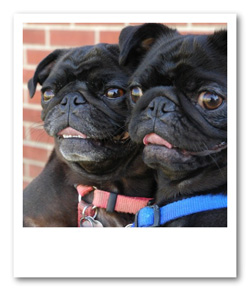 |
|
© mpa photography |
|
|
If this is the first time you've visited
the Caring for a Pug page and you have never owned a Pug, we
recommend you scroll down and read all of the information we've
provided. However, if this is a return visit, or you are only
interested in a certain topic, we've provided the index below to
make it easy for you to choose a particular subject.
|
|
|
|
|
The Essentials
The information below is courtesy of
The Humane Society of the United States , although some
changes
have been made to gear the information specifically to
Pugs.
Outfit your Pug
with a collar and ID tag that includes your name, current
address, and current telephone number.
No matter how careful you are, there's a
chance your Pug may become lost and having an ID tag greatly
increases the chance that your pet will be returned home
safely.
Follow local laws for licensing
your Pug and vaccinating him for rabies.
Check with your local shelter or humane society for
information regarding legal requirements, where to obtain
tags, and where to have your Pug vaccinated.
Off property, On Leash.
Even a Pug with a license, rabies tag and ID tag should not be
allowed to roam outside of your home or fenced yard. Keep
your Pug under control and safe at all times.
Give your Pug proper shelter.
For a Pug, this means to keep them as an
indoor dog and provide a fenced yard for times when they are
outside to go potty or play. A Pug should NEVER be
left outdoors for any length of time. They are not outdoor
dogs.
Take your Pug to a veterinarian
for regular check-ups.
It is important that your Pug receive regular check-ups.
It is also a good idea to know where the nearest emergency
animal hospital is located for any health issues that may
arise when your regular vet is not open.
Spay or neuter your Pug.
Pugs who have this routine surgery tend to live longer, be
healthier and have fewer behavior problems (e.g. running away,
marking). By spaying or neutering your dog, you are also
doing your part to reduce the problem of pet overpopulation.
Give your Pug a balanced diet,
including constant fresh water.
Give your Pug enough exercise to
keep him fit, but not exhausted.
Pugs can't tolerate strenuous exercise, such as
long runs or hiking. They do not have the stamina. But, they
will benefit from short walks and simply playing with their
owners.
Be loyal and patient with your Pug.
Make sure the expectations you have of your Pug are reasonable
and remember that the vast majority of behavior problems can
be solved.
|
|
|
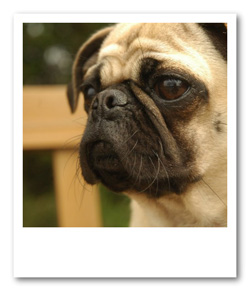 |
Pug Health Issues
Pugs are a Brachycephalic breed, meaning that they have a short
nose. Because of this they have greater chances of having breathing
problems such as: elongated soft palate, pinched or undersized
nostrils, and other respiratory ailments.
Stenotic Nares is a
condition often found in Pugs. It it a narrowing or restriction of
the nostrils. This puts a strain on the dog's system and can lead
to an enlarged heart. Signs of this condition are that the Pug
tends to mouth breathe or have a foamy nasal discharge. Surgery can
enlarge the nostrils and fix this problem.
Elongated Soft Palate is
when the palate is too long and it restricts air flow into the
lungs. It can also be surgically corrected.
|
|
© mpa photography |
|
Changes in
heat can be very difficult on Pugs and they should NEVER be left
outside in either cold or hot (greater than 70 degrees F) weather.
It is also important to note that not only does heat play a factor,
but also humidity. So, there may be days when you don't
consider the temperature to be "hot", but because it is humid, a Pug
may have a difficult time breathing and be quite uncomfortable.
Pugs should always be kept inside the house with their family. Air
conditioning in the summer months is essential. Signs of heat
prostration are common in Pugs and include difficulty breathing,
wheezing and heavy panting. Pugs in heat distress should be cooled
with water and taken to a veterinarian as soon as possible.
Most Pugs also have lots of facial wrinkles. The nose wrinkle
should always be kept dry and also be cleaned regularly. No air can
get in to dry moisture and Pugs consequently can get bacterial or
fungal infections. You can wipe the fold around their nose using an
antibacterial baby wipe. And while you're cleaning, don't forget
the ears...they need wiped out too.
Pugs, because of their slightly undershot jaw, can also develop
tooth and gum problems. You need to check the mouth for any signs
of problems, mouth tumors, retained baby teeth and should brush your
Pug's teeth regularly.
|
The Pug's
large eyes can develop many problems. It is important to get in
the habit of checking your Pug's eyes and if they seem dirty or wet,
put an eye wash in and clean them whenever necessary. A Pug's eyes
can get scratched easily and they can have eyelid or eyelash
abnormalities.
Trichiasis is ingrown eyelashes
of the upper eyelid, which causes irritation of the eye and can be
surgically corrected.
Distichiasis is a double row of
eyelashes that normally are on the lower lid and cause irritation.
This condition also requires surgery.
Entropion is an inward rolling
of the eyelids which usually causes the eyelashes or hairs to rub
against the surface of the eye, causing scratches, irritation and
ulceration. This is most critical and needs to be caught early and
surgically corrected to prevent complications.
Dry Eye is an eye condition
resulting from lack of tear production. The eyes will appear dull
and textured instead of lusterous and shiny. Treatment will depend
on the cause and severity of the condition.
Bilateral Cataracts will
appear as opaque spots on the lens of the eye. These spots can
cause partial or full loss of vision. Sometimes surgery can help.
Corneal Ulcers can occur
after any scratch or injury to a Pug's eye. Ulcers need to be
treated immediately or there will be some loss of sight.
Generalized Progressive Retinal Atrophy
is a hereditary eye disease causing the gradual breakdown of cells
of the retina and causing blindness. Pugs can be screened for this
condition.
Pigmentary Keratitis can
first appear as a small black or dark brown blob on the white of the
eye in the inside corners. It will gradually spread across the eye,
completely covering it and blocking the Pug's vision so that the Pug
is blind.
|
There are
various leg problems that can occur in Pugs.
Slipped Stifles (patellar
luxation) is when the patella (kneecap) slips out of position due to
hereditary or injury. Generally you will notice your Pug limping,
carrying the leg off the ground or hopping when running. If the
problem is severe it can necessitate surgery.
Hip Dysplasia is a
hereditary condition that causes the hip joint to be malformed so
that it is not properly aligned. Your veterinarian can x-ray your
dog's hips for evaluation.
Legg-Calvé-Perthes disease
is a conditon caused by improper blood flow leading to the
destruction of the hip joint. This most often occurs between the
ages of six months and one year.
|
Pugs have a
high incidence of Demodectic skin mites
(often called demodectic mange), especially when they are still
puppies. Mange does require a veterinarian to treat it. In regards
to the localized form, it usually occurs when Pugs are under one
year old and you may notice small patches of hair loss exposing
healthy looking patches of skin. Often they appear on the face or
forelegs. It appears gradually and after the patches reach their
maximum size, the hair begins to re-grow. It is important that if
you see these signs that you get your Pug to a vet immediately. The
generalized form of this condition can occur in Pugs of any age and
the exposed skin often becomes infected. This type can be very
difficult to treat and often is fatal. Again, it is very important
that you seek treatment at the first indication that your Pug may
have any type of this condition.
|
Pugs also
have high incidences of skin and inhalant allergies, seizure
activity, and recently we've begun to see more cases of spinal
problems as well. Encephalitis
is an inflammation of the brain which can cause seizures.
For a more comprehensive list of common Pug ailments, please
visit
Pugs.com. |
| |
General Pug Information
History - Pugs are a toy breed and
it is believed that they were first bred for the royalty of China
sometime before 400 B.C.E.
Appearance
- According to the breed standard, Pugs should be "Multum
In Parvo," which can be translated to mean: A lot of dog in a small
space. They weigh between 14 and 18 pounds, but it is quite common
to find Pugs that weigh either more or less than that. Their bodies
are shaped like little squares and they are as tall as they are
long.
Pugs come in two colors, fawn or black. Fawns will have a dark mask
of rich black covering their faces and ears and maybe even some
black going down their back in what is called a "trace." The blacks
are solid black all over, but it is common for white hairs to sneak
in. |
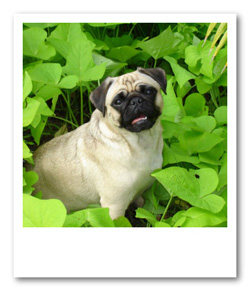 |
|
The eyes of the Pug are
large and have a beautiful dark brown color and their little tails
curl jauntily over their backs. Then of course, there are all those
Pug wrinkles and a flat little nose. In China, Pugs were valued for
their wrinkles because the owners could sometimes make out shapes in
them that were reminiscent of Chinese Calligraphy.
Personality
- The Pug's personality is most people's favorite part of this
delightful little dog. They are always inquisitive and playful,
often seeming to be more like little people than dogs. Pugs have a
wonderful sense of humor and always seem to know what their humans
are thinking...usually turning it into an excuse to beg a treat or
two. They love people and other pets, are very easy going, and hate
to be left alone. Pugs like to be a part of everything that their
families do. |
| |
Shedding
Pugs shed year round and they shed A LOT! A good diet and
weekly grooming can help control the amount of hair that ends up in
your house, on your clothes, etc. But, there is no way to stop a
Pug from shedding. You should comb/brush your Pug at least once a
week, as well as bathe them once every 3 to 4 weeks. This will also
help control parasites and keep their skin healthy. If your Pug
really hates the comb/brush, and just will not tolerate it...you
could always use your fingers and give them a massage, scratching
all around to remove the dead hair.
|
| |
Reverse
Sneezing
Many Pug owners have experienced their dog having what appears
to be a "breathing attack". It can be quite frightening to see for
the first time. Reverse sneezing is characterized by a series of
forced inhalations, and snorting through the nostrils (gasping
inwards). It may last for a few seconds or up to 1 minute or more.
These attacks often occur on a sporadic, unpredictable basis.
Pugs usually have the head extended forward and stand still during
the attack. There is no loss of consciousness or collapse. Many Pugs
and other dogs have these attacks throughout their lives. The exact
cause of reverse sneezing is unknown, but it may be associated with
sinusitis and other upper respiratory disorders. Many believe
affected dogs are consciously removing mucus from the nasal
passages. In fact, many dogs swallow at the end of the attack.
Occasionally another possible cause is a foreign body lodged in the
nostril or it could be an allergy to something causing/exacerbating
the problem. Whatever the cause, the condition is usually not
serious. If the condition appears suddenly in an older dog or if
episodes become more severe or frequent, the nasal passages and
throat should be examined by a vet.
Treatment
Treatment is not necessary when the episodes occur infrequently on a
random basis. Calming your Pug during an attack may shorten the
episode. Massaging the Pug's throat gently may help. Worsening
episodes may need to be treated medically. Consult your vet for
advice if you are worried.
Watch for these Signs:
1. The severity or frequency of the reverse sneezing changes.
2. Your Pug develops a discharge from the nose or a cough.
3. Your Pug appears sick.
Remember though, your vet is the best person to help diagnose the
problem and advise you on how to best manage it.
Information courtesy of Sharda Baker
www.MyPerfectPug.com
|
| |
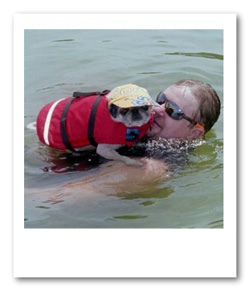 |
Pugs and Swimming Don't Mix
Pugs do NOT make good swimmers. They
are heavier in the front, causing them to sink. If you plan on
taking your pug with you on your boat or to another water activity,
please have them wear a doggie lifejacket. Even if you keep them n
the very shallow water along the shoreline, please supervise them
100% of the time.
|
| |
Potentially Poisonous Foods and Household Items
NEVER GIVE YOUR PUG CHOCOLATE.
Chocolate is poison to your dog.
According to
The Humane Society of the United States, the following are all
potentially poisonous to dogs:
alcoholic beverages
cherry pits
mushroom plants
peach pits
tea (caffeine)
tomato leaves and stems
avocados
chocolate
coffee
apple seeds
macadamia nuts
mustard seeds
rhubarb leaves
walnuts
apricot pits
moldy foods
onions and onion powder
salt
yeast dough
potatoes
|
| |
Safety
The best way to keep your Pug safe is to
have a fenced in yard or an area of your yard especially for your
Pug. A fence will help keep your Pug safe from getting hit by cars,
attacked by larger dogs, kidnapped by strangers or getting lost.
Anytime you are outside with your Pug and it is not in a fenced
area, you will need to be there to supervise your Pug and keep them
on a leash to protect them. Please be sure that you can get two
fingers comfortably between the collar and the neck of your Pug.
When walking your Pug, it's best to use a harness that doesn't wrap
directly around the neck. Pugs are prone to collapsing trachea, so
using a regular collar for walks (especially if your Pug walks ahead
of you and/or pulls) can put unnecessary pressure on this area. |
| |
Introducing Your
new Pug to Other Pets
It is difficult to
predict how your new Pug and current Pugs or other pets will get
along. Problems are more likely to occur between 2 adult
animals. Adult Pugs usually will tolerate the clumsiness of puppies
and juveniles, but this is not a guarantee. A lot will depend on the
personalities of the animals. Of course, you also will need to
take into consideration the sizes, ages and breeds of the animals.
Your current Pug/dog may be very laid back and easy going on his/her
own, but when a new Pug is brought into the home they may view the
newcomer as a threat to their "place in the pack". When
introducing your new Pug to current Pugs/other pets, they should be
supervised at ALL times until you are confident that they can
cohabitate peacefully by themselves. |
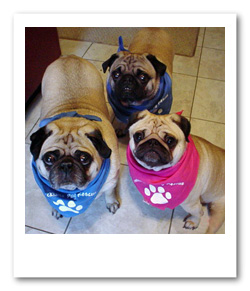 |
Some pets will
become best friends, inseparable companions. Others will
merely learn to tolerate each other. And there are those that
even with the utmost patience, will simply not be able to coexist
peacefully and will need to be permanently separated.
Introducing a Pug to another Pug/dog -
Controlled
Environment - Chose a place to introduce your Pug where
you will have control. Reduce stress as best you can by
selecting a calm setting. Outdoors, you will definitely want
to use a leash. Even indoors, leashing may help.
Introductions done at a neutral area are best...even if it's in your
own yard, just choosing an area of the yard that your current
Pug/dog doesn't frequent. It can also be beneficial, if you
are introducing your new Pug to multiple current Pugs/dogs, that you
do so on a "one on one" basis. Once your new Pug has had a
chance to meet their new housemates individually, then you can do a
group introduction.
Constant
Supervision - This means keeping your new Pug confined to
a separate room or in a crate when you are not able to be there to
supervise them. It can take days, weeks or even months before
all can be left alone without supervision. Even Pugs that seem
to get along fine during their introduction, may have disagreements
or fight days later when you least expect it. A new Pug may
not show his/her true personality until they are fully settled and
comfortable with their new surroundings
Getting Familiar - It can help
to confine your current Pug/dog to a separate room, letting your new
Pug have a chance to explore his/her new home on their own before
making introductions.
Patience - Don't force your new
Pug and current Pug/dog to interact. Let them check each other
out at their own pace.
Problem
Solving - If disagreements and scuffles occur and you are
not comfortable with the animals being together, even when
supervised, there are steps you can take to make the introduction
smoother. You can put up a baby gate and keep your new Pug on
one side and your current Pug/dog on the other. This lets them
smell and see each other without being able to get at one another.
Special Tips for Introducing a Pug to a Cat -
When attempting to introduce a Pug and a
cat, it's always best if they are both young...or if they are
adults, that they have both had positive experiences with the other
species in the past. When you have a cat and are adopting a
Pug, your best bet is to chose a Pug that has a good history of
getting along with cats. It also works the other way.
You don't want to adopt a Pug if you know that your cat does not
tolerate dogs.
When making introductions between a Pug and a cat, you will
definitely want to keep your Pug on a short leash. Again, you
want to make sure you have complete control of the situation.
Do not tolerate any aggressive behavior from your Pug. Do not
let them chase or corner the cat. If a Pug has a strong
predatory instinct, it can attack with little advance warning.
Most people may only be worried about the Pug hurting the cat, BUT
please be aware that a cat can just as easily injure a Pug by
scratching or biting them. A cat that
still has its claws, even if only playing, can do permanent and
severe damage to a Pug's fragile eyes. |
| |
Weight
Management -
The AKC Pug Standard
says that a pug should weigh between 14
and 18 pounds. However, there are many Pugs that weigh between 20
and 24 pounds and are healthy at this weight. The best way to find
out your Pug's ideal weight, is to ask your veterinarian. They will
be able to examine your pug, and based on bone structure, height,
etc. tell you the ideal weight range for your Pug.
Although Pugs can't tolerate hard, strenuous exercise such as
running or long walks, that doesn't mean that they don't need
exercise. Exercise will help your Pug maintain a healthy weight.
You can take them on short walks, just monitor your Pug's
breathing...if it seems labored, you can pick your Pug up and carry
them for awhile. You can also purchase a dog stroller for your Pug.
That way, they can enjoy longer walks with you by hopping in the
stroller to take breaks along the way. Be aware of the weather
also. Do not walk your Pug on very hot or humid days.
Don't overfeed your pug or feed them table scraps. Pugs love to eat
and it is hard when they look at you with those big, sad eyes and
beg for food. But, an overweight Pug will face added health
concerns, such as kneecap issues, hip dysplasia, as well as heart
and breathing problems.
Some healthy treats include carrots, fat free yogurt, cheerios,
apple pieces (NOT the seeds), and cooked green beans. |
| |
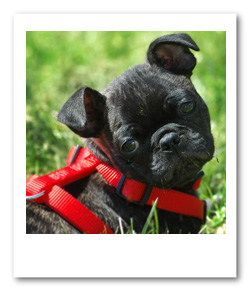 |
Housetraining a Young
Pug or Puppy -
You will need to buy a crate to confine
your pug when he can't be supervised. The crate should only have
enough room for your pug to stand up and turn around in. If it is
too large, he will be able to relieve himself in one end and sleep
in the other.
Never leave the puppy to run the house unsupervised. If you are not
watching them every minute, they can have an accident and you might
not even know it...until it is too late. If the puppy is having
little accidents around the house that you are unaware of, that
means you aren't cleaning them up and the puppy will be drawn to
that spot the next time they need to relieve themselves. If you
aren't able to supervise your puppy 100%, then you should put
him/her in the crate or somewhere they are safe and contained. |
|
© mpa photography |
If you are like many people, you often feel guilty having to put
your Pug in his/her crate. It helps if you utilize the crate
only for long periods of time, such as at bedtime. You can use
a play yard enclosure, which is more open and gives your Pug more
freedom when you need to contain your Pug for short periods of time.
Maybe you are cooking, need to make a quick trip to the bathroom or
to take a shower, etc. You can place the enclosure on a vinyl or
linoleum floor and line the bottom with newspapers in case of an
accident. Often people will gate off a kitchen, bathroom or
other small area for use to contain their Pug.
Keeping to a schedule is very important. You should take your Pug
outside when they wake up (not 20 minutes after they wake up, but
immediately when you notice they are awake). They should also be
taken out after eating or after drinking a lot and after they've
been playing hard. In other words, you will be taking them outside
at least every 2-3 hours. After several days, you should be able to
get into a pretty good schedule for potty times. Always take your
Pug to the same area. You should use a 'trigger words' such as "go
potty" or "hurry up" to let your Pug know what you expect of them.
Be sure to take a snack with you...keep it in your pocket. As soon
as you see your Pug start to relieve himself, praise him by saying
"good boy" and as soon as he is finished, give him the snack.
Do not play with your Pug when you take him outside. This will
confuse him. You want him to only relate the act of going potty
with going outside right now. When he's older and you are sure he
is 100% housetrained, then you can begin taking him outside for play
time too.
Even after your Pug seems to have the hang of going potty outside
during the day, he may still have problems at night. Don't expect a
puppy to be able to "hold it" all night long. Some dogs are 6
months or older before they are able to accomplish this. To make it
easier for him, try not to give food or water after 8 p.m.
Sometimes, just when you think they have the hang of it and you
start bragging that they are potty trained...your Pug has an
accident. The best advice is...be patient...be patient...and be even
more patient.
You will not be able to housetrain your Pug by merely leaving it in
the play yard or crate all the time and taking it outside every
couple of hours. A Pug needs socialization...needs to be out of the
play yard or crate when you are there to supervise them. Pugs need
this interaction.
Accidents will happen, even to the best Pug and best Pug trainer.
If your Pug does happen to have an accident in the house, and you
catch him in the act, you can shout a firm "NO", pick him up and
take him outside to the designated area. Proceed to give the
'trigger word(s)' and if he does finish outside, be sure to praise
him.
When you clean up the accident, don't let him see you cleaning it
up. Be sure to use an odor neutralizing cleaner. Simply blotting
it up with some soap and water, or sprinkling on some carpet fresh
will NOT work. Your Pug will still be able to smell the scent.
There are a lot of products on the market designed especially for
removing/neutralizing pet stains.
If you find an accident after the fact, there is no need to scold
your Pug. He won't know what he's being scolded for. Yelling will
only make him confused and afraid.
If you are able to utilize a doggie door that leads into a fenced
area, then your next step is to introduce the doggie door. The time
frame here really depends on the Pug, i.e. whether you feel he
understands what is expected of him when you take him outside and
say "go potty", etc. When you are ready to introduce the doggie
door, the best way is to have someone on each side of the door. Sit
the Pug inside, beside the doggie flap, and have the person on the
outside attempt to coax him through. You may have to use treats.
You may want to push the flap open and show him that it leads to the
outside. If he absolutely will not use the door to go
outside...then put him on the outside, and try coaxing him in...this
may be easier.
If you have a Pug that was previously housetrained and they start
having urine accidents, you should take them to your veterinarian to
be checked for urinary tract, bladder, kidney infections or bladder
stones.
|
| |
Marking -
Urine-marking is not a housetraining
problem. It is considered territorial behavior. In order to stop
marking, you have to find out why your Pug feels the need to mark
his territory. If you are sure that your Pug is potty trained and
you have ruled out a medical issue, such as a urinary tract
infection or bladder stones, then your Pug is most likely marking.
Although you hear mainly about males marking, females will do it
also.Males that have not been
neutered, and females that have not been spayed, are more likely to
begin marking, so getting your Pug neutered / spayed as early as
possible is important (usually before 5-6 months, but ask your
veterinarian for the ideal age). Pugs that were neutered / spayed
after they had already reached maturity and had already begun
marking, may be in the habit of doing so and continue even after
they are neutered.
Marking often occurs when introducing an older Pug into a new home.
Everything is new to them and they may feel the need to "mark their
territory" or "stake a claim". It is possible to stop a Pug's
marking behavior if you are vigilant and scold him every time you
catch him getting ready to mark or in the act of marking. You
may also want to utilize a belly band for males or a diaper for
females to help stop the behavior.
For more information on marking, please visit
The Humane Society of America. |
| |
Housebreaking an Older Pug -
Maybe you've brought an older Pug into
your home. You should follow the same process, crating the Pug when
he can't be 100% supervised, taking him to one designated area,
using praise and snacks and developing a schedule. With an
older Pug, they won't need to go out as much as a puppy because
their bladders are larger and they have more control. Even if
you adopt a Pug that is completely housebroken, it is a good idea to
follow these guidelines until the Pug is accustomed to their new
home.
|
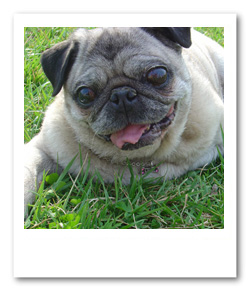 |
| |
Breeding
-
If you are considering getting Pugs so
that you can breed them, please consider all the facts. Pugs have a
high incidence of C-sections. This means that having a litter of Pug
puppies can be quite expensive and very time consuming for you. A
female who has had a C-section may not be willing or able to care
for her puppies in the first few days. You will have to do it,
including bottle feeding and keeping them warm. Even if your female
is able to deliver naturally, she should be supervised (especially
first time mothers). Do you have the time to make sure things go
smoothly with the delivery and after care? You may have to take
time off work. Puppies can be born with health concerns. This
means more expense and a sick puppy can mean even more time off
work. In other words, if you think breeding Pugs will be fun or a
way to make a lot of money, you're wrong. It can cost you a lot of
money and/or end up being a heartbreaking experience for all
involved.
Kentuckiana Pug Rescue will not adopt out an unaltered Pug and will
not allow someone who has any unaltered pets adopt a Pug. KPR
has very strong feelings about the pet overpopulation and feels that
all pets should be spayed and neutered to prevent overpopulation
problems. |
| |
Why do Pugs end up in Rescue?
Many Pugs are surrendered to a Rescue
due to circumstances beyond their owners' control. Relocation
from one home to another (where dogs aren’t permitted), divorce,
major illness, and other lifestyle changes may cause someone to be
forced to give up their Pug. A Pug's illness, coupled with the
owner's financial difficulties is another reason Pugs are often
surrendered to a Rescue organization.
Sadly, their are other reasons Pugs end up in Rescue.
Sometimes, it's because people didn't do the necessary research
before bringing home a Pug. They bring home a cute, cuddly
puppy, only to find that there is Pug hair everywhere because Pugs
shed 365 days a year, and they decide this isn't what they wanted.
Often, they don't realize how much responsibility is involved in
owning a Pug, or the amount of time they have to invest to properly
care for a Pug, and they decide they no longer want him/her. Others
get Pugs as gifts for their kids, expecting their kids to take care
of it and when they don't, the Pug has to go. Then there are
the people who simply get "tired" of their Pug...the novelty wears
off...and they just decide to get rid of the dog.
Suffice it to say, for whatever reason, many many people treat their
dogs like disposable objects and throw them away without hesitation,
care or concern for what happens to the dog, or for their own
inhumane and selfish behavior.
Pug Rescue organizations exist to help these Pugs end up in loving,
appropriate homes. Their efforts are a labor of love to be sure, but
the ultimate goal of all Pug Rescue groups is to see a day when
there is no longer a need for them to exist. |
| |
|